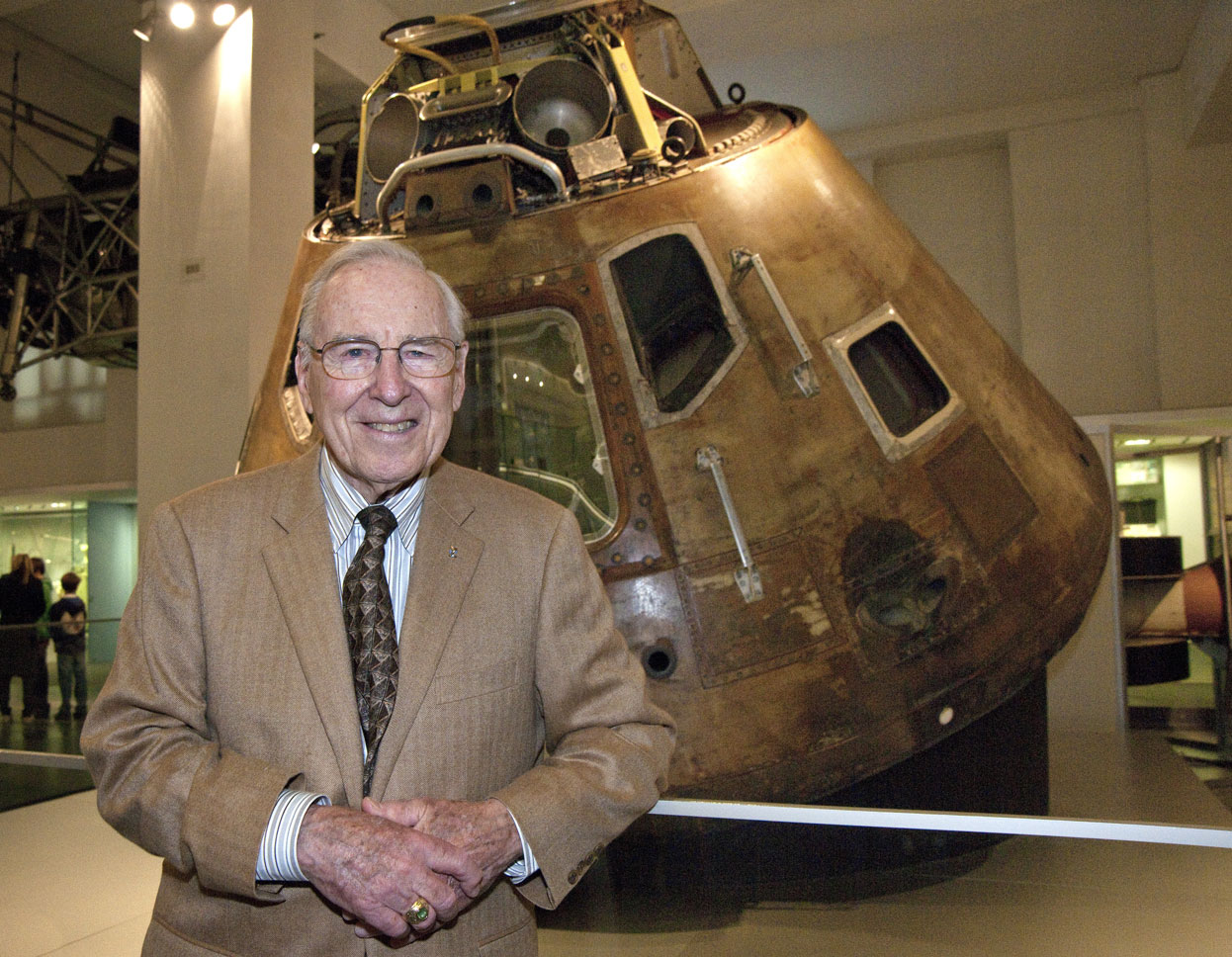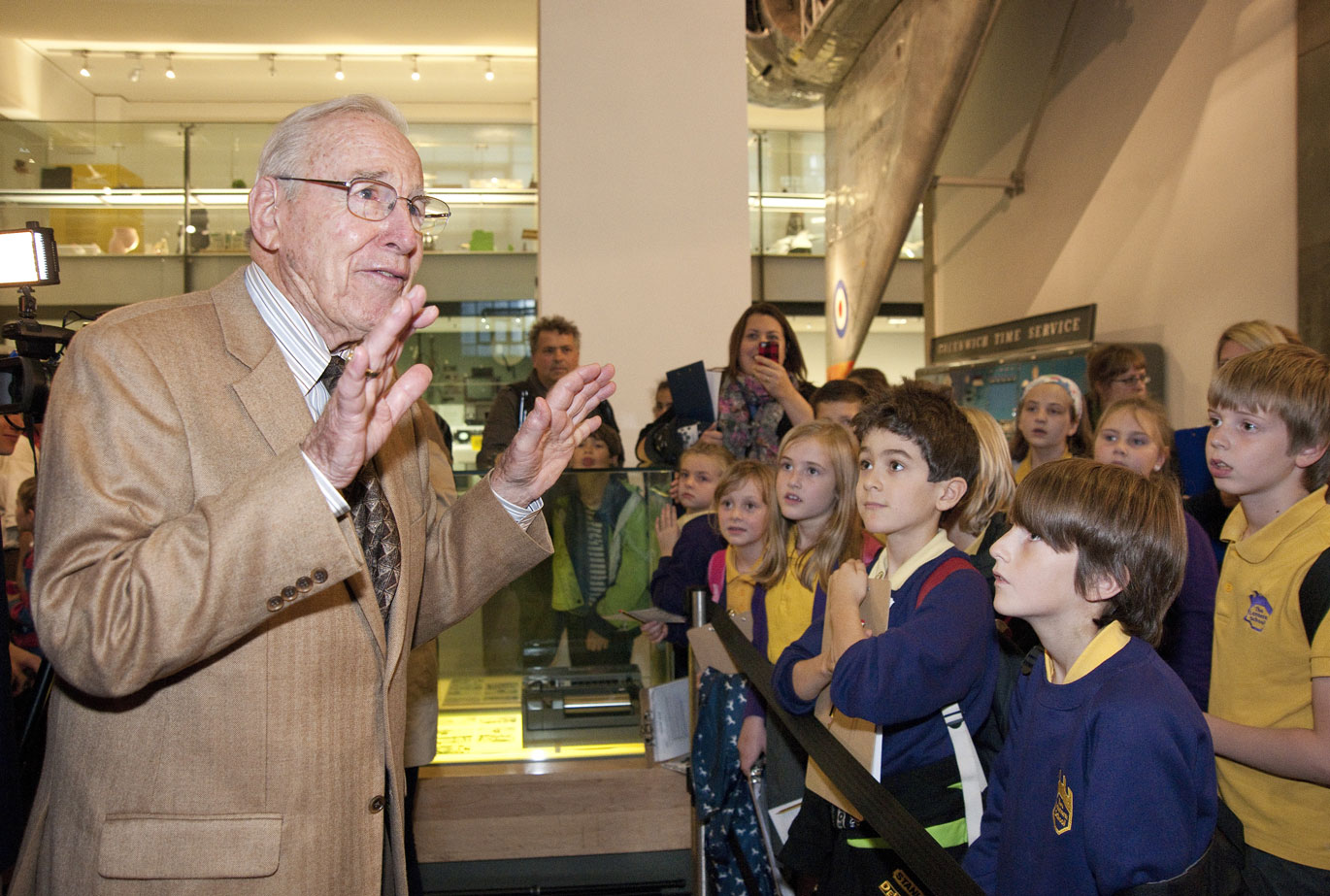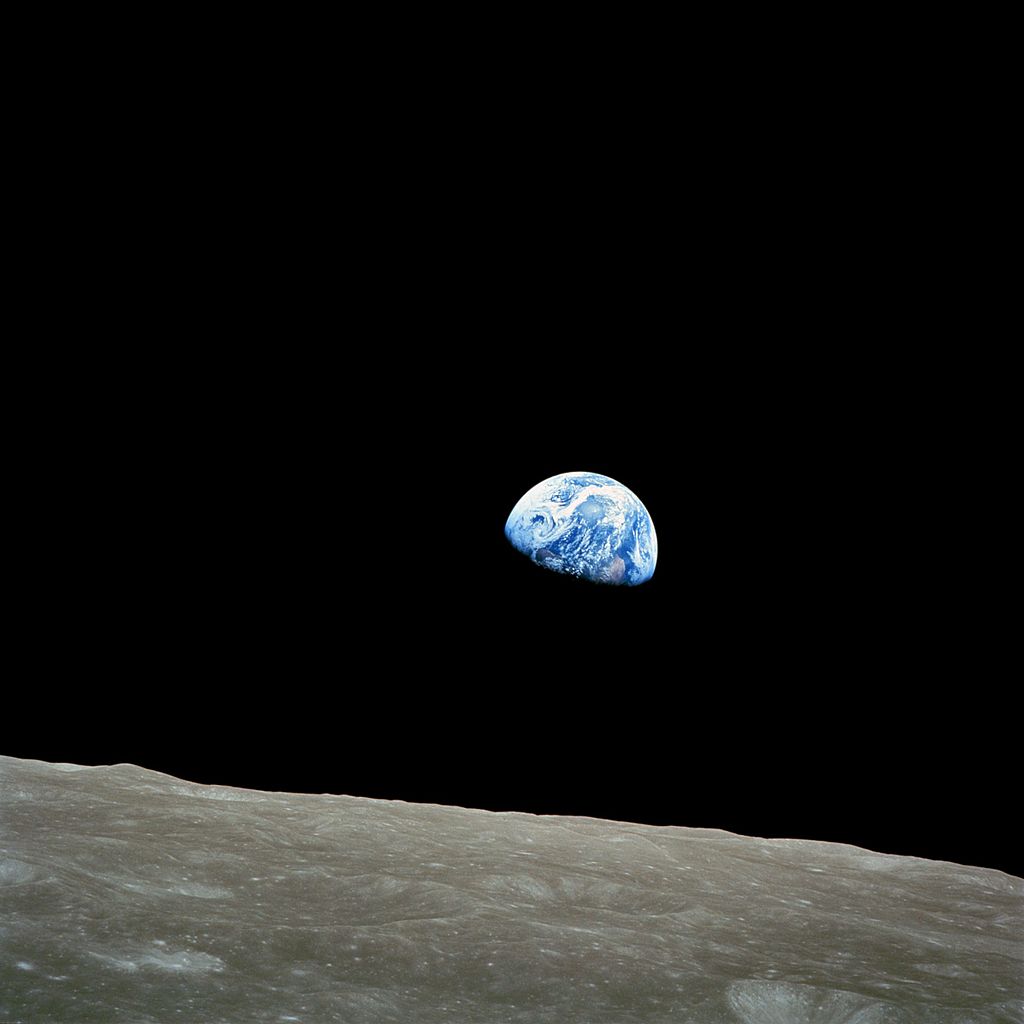Captain Jim Lovell, the astronaut who led the crew of Apollo 13 to safety after their spacecraft was crippled by an explosion, held an impromptu question and answer session for school children today in the Science Museum.

His astonishing adventure, popularised by the film of the same name starring Tom Hanks, began when the Apollo 13 spacecraft lifted off on April 11th 1970 to land Captain Lovell and Fred Haise on the Moon, with Jack Swigert to pilot the command module.
Jack Swigert, responding to a daily request from Earth, switched on the cryogenic fan to stir up the contents of the oxygen tanks. A spark flew from a naked wire, causing an explosion that ruptured the oxygen tank. The lunar mission was doomed 200,000 miles out in space
Swigert saw a warning light that accompanied the bang, and said, “Houston, we’ve had a problem here.”
Quick action by the crew, who used the lunar module as a “life boat”, and dazzling improvisation by technicians on the ground salvaged the crippled spacecraft and brought it back to Earth within four days.
Lovell was visiting the museum today to accept the Guild of Air Pilots and Air Navigators’ premier award, its Guild Award of Honour for Aviation Heroism and Professionalism, from “the Flying Judge”, Tudor Owen QC, Master of the Guild.
But, while posing for photographs in front of the Apollo 10 Command Module which is on display in the Science Museum, he decided to take questions from a crowd of schoolchildren who were visiting.

‘Were you scared when you came back,’ asked one girl. ‘I was scared before I came back,’ came the reply. ‘After I landed I was very happy that I was back on the water and our spacecraft didn’t sink.’
What was the explosion like? ‘It was quite violent, although we did not know exactly what it was at first. We thought maybe a battery had blown up and then we saw oxygen escaping. When that occurred, we knew we had lost an oxygen tank. We actually lost both oxygen tanks.’
How does it feel in space? ‘It is actually very comfortable when you get used to it.’
Lovell flew in space four times; as pilot on Gemini 7 in 1965 and as Command Pilot on Gemini 12, before his two Apollo missions.
He is the only man to have flown to the Moon twice, but not landed on it. He went in orbit around the moon in Apollo 8. Earthrise, one of the most iconic images ever, was taken from the spacecraft.

Captain Lovell also met Doug Millard, Deputy Keeper, Technologies & Engineering, who is working on a landmark museum exhibition about Russia’s space pioneers, scheduled for next year. Lovell later remarked that, during the crisis, the Russians had offered help with recovering the command module, after re-entry.
A few weeks ago, fellow Apollo astronaut Gene Cernan also visited Apollo 10. Cernan was the last man to walk on the moon.
With Jeffrey Kluger, Jim Lovell wrote a book about the Apollo 13 mission, Lost Moon: The Perilous Voyage of Apollo 13 Here are some extracts from the book, which was the basis for the later Ron Howard movie Apollo 13:
“A short, muffled blast echoed through the spacecraft. It rocked for a few brief seconds, then settled down and quiet again prevailed. I could tell by Fred Haise’s expression that he didn’t know what had happened. A quick glance over to Jack Swigert told me the same. Jack’s eyes were as wide as saucers.”
“Powering down meant everything. The only items left operating were the radio to talk to Earth and a fan to circulate the atmosphere in the spacecraft. We were flying on the seat of our pants. But again we ran into problems. The altitude control rockets were never designed to control the altitude of the lunar module with a dead 60,000 lb command and service module attached to it, so, without the autopilot, I had to fly it manually. Pushing forward on the controller did not result in a pitch-down motion but some wild gyration in another direction. I had to learn to ‘fly’ all over again.”
“If we came in at too shallow an angle, we would skip off the atmosphere like a stone off water. If we came up too steeply, we would burn up in seconds like a meteor.”
“The procedures called for manually rotating the spacecraft, using our newly acquired ‘flying skills’, to put Earth in the lunar module window. In that window I had mounted a crosshair ‘gunsight’. If I could line up the terminator on Earth, the line between daylight and darkness, with the horizontal line of my gunsight, then the lunar module’s descent engine would be properly positioned to correct our angle of entry into the atmosphere.
We had only one chance to make the manoeuvre: at the point in our flight home when we had just left the sphere of influence of the Moon and had the least forward velocity. Aquarius’s clock had failed, so I told Jack to time the burn with his Omega wristwatch. I had two three-axis attitude controllers in Aquarius, the primary and a back-up. I told Fred to use the back-up controller to maintain yaw control. I would control pitch and roll with the primary controller. Two emergency electrical buttons were located on the left side of the console. One was labelled ‘Start’ and the other ‘Stop’.”
“At the proper time, I pushed ‘Start.’ The engine came on full blast. Fred and I jockeyed Earth in the window. Fourteen seconds later, Jack yelled ‘Stop!’ and I pushed the button. Mission control monitored the burn via telemetry: ‘Ignition!… Thrust looks good… It shut down…Nice work.’ ‘Let’s hope it was’, we replied. Space networks radars soon confirmed that Apollo 13 was comfortably back within the entry corridor.”
“I was in Aquarius, straining to get a glimpse and photograph the service module as it drifted by: ‘OK, I’ve got her… There’s one whole side of that spacecraft missing: right by the high gain antenna, the whole panel is blown out, almost to the base of the engine – it’s a mess.”
“At 142 hours 40 minutes elapsed time, Odyssey slammed into the thin upper air at about 400,000 ft. A pink glow came through our windows, when the atmosphere started to decelerate the spacecraft, and the temperature on the heat shield rose to 5000F. When we reached 40,00ft, the drogue chutes popped out, followed by three beautiful main parachutes. Odyssey splashed into the Pacific Ocean just a mile or so from the USS Iwo Jima on Friday, April 17, after a flight lasting 142 hours, 54 minutes and 41 seconds.”
Roger Highfield, Director of External Affairs spoke to Apollo 13’s Jim Lovell at the Science Museum.
One comment on “Apollo 13’s Jim Lovell Inspires The Next Generation”
Comments are closed.
Visiting the museum of science and industry and in particular the space hall really got me interested in space exploration as a child. I used to love going there. I was also utterly inspired by the apollo missions.